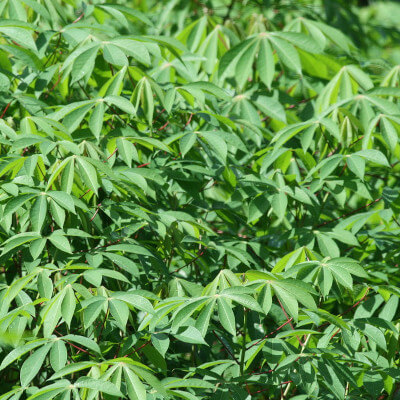
Manihot esculenta, more commonly known as cassava, is a tropical perennial plant originally from South America, now widely cultivated across tropical and subtropical regions of the world. Highly valued for its starchy tuberous roots, it serves as a vital source of carbohydrates for millions of people. At the Au Bois Vert botanical garden, this plant stands as a fascinating example of tropical biodiversity, appealing both to botany enthusiasts and to visitors interested in sustainable farming practices.
Cassava is easily recognised by its long, palmate leaves in a vibrant green, adding a decorative touch to gardens such as those in Ivato or around the lodges of Bois Vert. Its woody stem, which can grow up to three metres tall, gives it remarkable resilience in the face of dry or challenging climatic conditions. This hardiness makes cassava a crucial crop in poor soils where other plants may struggle to thrive.
In the wild, cassava favours warm climates with moderate rainfall, yet it adapts surprisingly well to a range of environments. During dry spells, it remains vigorous thanks to its deep roots that store both water and nutrients. Its rapid growth cycle and low maintenance needs make it an excellent choice for gardens and agricultural plots alike.
Featured in the Antananarivo botanical garden, cassava offers visitors a unique opportunity to discover a plant that not only sustains local communities but also plays a role in supporting ecosystems. Guests staying at the Au Bois Vert hotel and restaurant can learn about its significance in Madagascar’s agricultural and culinary traditions.
Plant use
Cassava is one of the most versatile plants in the world. Both its roots and leaves are widely used in human and animal nutrition. The starchy roots are consumed in various forms: as flour, tapioca, or simply boiled or grilled. This tuber is a key ingredient in many traditional Malagasy dishes and is often served in local lodges and restaurants, such as at Au Bois Vert. However, it's important to note that some varieties of cassava contain toxic compounds (cyanogenic glycosides) that must be removed through proper cooking or fermentation. Once processed, the roots become a highly digestible and energy-rich food. The leaves, on the other hand, are eaten as a nutritious vegetable, rich in protein, vitamins, and minerals. They are commonly featured in traditional recipes, such as the Malagasy dish ravitoto. Beyond its role in food, cassava also has industrial applications. Its starch is used in the manufacture of paper, textiles, and even bioplastics. The plant plays a crucial role in supporting food security among rural communities in and around Antananarivo. In household gardens, cassava is valued for its ability to improve soil fertility and provide consistent harvests throughout the year. At the Au Bois Vert botanical garden in Ivato, cassava is highlighted not only for its agricultural significance but also for its cultural and economic impact. Visitors can learn how this plant is utilised both locally and globally, gaining insight into cassava’s importance in ecosystems and traditions alike.
Key information
| Common name | Cassava |
| Scientific name | Manihot esculenta |
| Origin | South America |
| Natural habitat | Tropical and subtropical regions |
| Life cycle | Perennial |
| Flowering period | Varies according to weather conditions |


